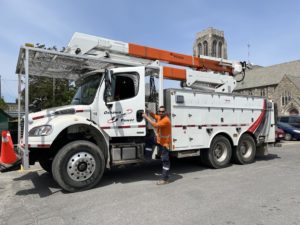Heating and cooling your home is no small expense. It’s estimated that more than 60% of your home energy costs are associated with keeping your home cool in the summer and warm during the winter.
However, installing a heat pump could be the answer to driving down your heating and cooling costs and saving you hundreds of dollars every year. Heat pumps offer an efficient alternative that can replace both your heating and cooling systems (some can even replace your water heater!).
From saving you money on your bills, to decreasing your carbon footprint, and reducing maintenance costs, the benefits of heat pumps make them a great choice for your next home energy upgrade.

What is a Heat Pump?
Heat pumps are devices that move heat from one location to another. Simple right? But how do they work?
While many different types of heat pumps are available, the basics remain the same; they are a heat transfer device. By moving, or transferring, heat from one location to another rather than burning fuel, heat pumps can operate at a much higher efficiency (up to 600%!) than other HVAC solutions.
In simple terms; a heat pump will transfer heat from the outside air to heat your home or transfer heat from inside your home back outside to cool your home.

Benefits of Heat Pumps
We’ve put together a list of some of the benefits of heat pumps to help you decide if installing a heat pump makes sense for your home:
Heating and Cooling Savings
Let’s get this one out of the way: do heat pumps offer savings over traditional HVAC systems? Yes!
Heat pumps can reduce the cost of electric heating by up to 50%. For homes heated with natural gas, heat pumps can still lead to yearly savings of more than $100 (and rising).
Lower Maintenance
Compared to traditional HVAC systems, heat pumps have the benefit of a much less grueling maintenance schedule. Regular yearly maintenance can generally be accomplished by the homeowner, with professional check ups recommended every 3 to 5 years.
As a bonus, heat pumps often replace two systems; your A/C and furnace, decreasing the need for maintenance even further!
Rebates and Loans
While the benefits of heat pumps are obvious, the installation cost can be a hurdle for many homeowners. However, with many local and federal programs in place to help retrofit your home, you may be eligible for grants, rebates, and/or low-interest loans to make a heat pump more affordable.
Increased Efficiency
For the environmentally conscious, heat pumps offer a massive opportunity to reduce your personal carbon footprint. Recent numbers show that heat pumps can reduce your carbon consumption for heating and cooling by between 20% and 70%.
Safe Choice
With no internal combustion, heat pumps offer a safer solution for your home. Switching to a heat pump can help make furnace fires and carbon monoxide leaks a thing of the past.

Is a Heat Pump Right For Me?
Heat pumps are a great solution for most residential spaces, but aren’t ideal for everyone. To find out if a heat pump is right for your space, check out the Durham Greener Homes program and book a free consultation with a Home Energy Coach.
Your Home Energy Coach will help you determine if a heat pump is right for your home, what other energy efficiency upgrades you could benefit from, and help you find rebates and low-interest loans to make your home retrofit affordable.













